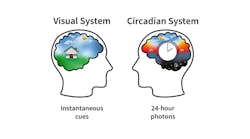This article was published in the September 2011 issue of LEDs Magazine.
View the Table of Contents and download the PDF file of the complete September 2011 issue.
+++++
After 18 rigorous months of testing Philips’ candidate LED lamp, the US Department of Energy (DOE) announced on August 3 that Philips has won the Bright Tomorrow Lighting Prize (L Prize) competition in the 60W-replacement-lamp category. Philips is busily preparing the lamp for production and sale late this year or early next.
The DOE launched the L Prize competition in 2008 to encourage the development of more-efficient SSL products and help build a US LED lighting industry (www.ledsmagazine.com/news/5/12/11). Philips was the only company to enter the contest and submit lamps for testing, although earlier this year Lighting Science Group (LSG) and GE Lighting submitted letters of intent to enter. Originally the contest was to have three categories – 60W replacement, PAR38, and 21st Century lamp – but the PAR38 contest is on hold and the 21st Century lamp category was never formally launched.
Still, the 60W-replacement category was clearly the prime focus as that’s the most widely-used incandescent lamp and therefore provides the greatest potential for energy savings. Moreover the DOE put the largest prize – $10 million, purchase guarantees, and explicit promotion of the winner – on the 60W category. The contest came with stringent performance requirements, and Philips delivered the winner with specs exceeding those requirements, including 910-lm output at 9.7W, corresponding to 93.4 lm/W efficacy (www.ledsmagazine.com/news/8/8/8).
Philips was naturally delighted at the announcement – see “Philips savors L Prize” column at right. We also had the opportunity to discuss the L Prize program with DOE SSL Program Manager Jim Brodrick, in the following Q&A session.
LEDs Magazine: Did the DOE achieve its goals with the L Prize program?
Jim Brodrick: Oh yes. Of course, there is more yet to come as Philips gets something on the market. Philips put a lot of time and money and talent into doing this. They went after this very difficult challenge to move the technology envelope. It’s definitely an achievement considering that they submitted this in the fall of 2009.
This has raised the competitive bar. All of the other companies are looking at this and they want in. They want something in that competitive zone. The ante is up, and the competitors are responding.
From the DOE perspective, we want to save energy and save the consumer money. With this very high efficacy lamp there is a lot of energy and money to be saved.
You have a new consumer option. Boy, there has never been something quite this efficient that looks and operates just like an incandescent lamp except for two things: 25,000-hour life and 90 lm/W efficacy. That means you are going to have about 10W – actually a pinch less – in that socket. You are opening up a new paradigm. You may well screw this into a socket and never remember the day or the year that you installed it. Lighting moves into a new zone.
And last but not the least is US jobs. They are going to manufacture this right in the US. What’s not to like?
Did you expect more companies to enter the contest sooner or did you know that you set the bar so high that it would be tough for anybody to enter?
We originally designed the contest and we wanted more of a horse race, sort of get everybody involved. But then it became a little obvious that this was so darn high that it was going to be very difficult to do. You have to have the right mix of people and capabilities to enter the contest as early as Philips did. We hoped for one way and it didn’t quite work that way. But we sure have a great lamp coming out of the contest.
LSG and GE submitted intentions to enter. And the DOE had said that as many as three companies might ultimately be judged to have met the entry requirements and therefore be eligible for promotions even though only one would receive the cash prize. Do you expect LSG and GE to follow through and submit samples for testing?
We’ve closed the contest completely. We won’t be doing any testing. That doesn’t mean that LSG and GE can’t continue and put their bulb out on the market. I hope they do. But the A19 60W replacement contest is completely closed.
Rumors suggested that the DOE couldn’t pay the cash award, given the US budget situation. Could you comment on that?
The $10 million was paid within 24 hours of the award. We’re looking for them to set up the manufacturing and start to produce the lamp. We’d like to see lots of sales.
We were a little bit surprised that they wouldn’t be manufacturing it a bit sooner. Was there any requirement that they have the lamp ready for market to be judged the winner?
They were asked to submit a lot of material on their manufacturing capability and plan so that we could see that at least 75% of the content or the assembly cost is based in the USA.
Keep in mind that they have the EnduraLED 60W lamp on the market. And some of the technology in the EnduraLED lamp came out of this L Prize program. So a byproduct of the contest is that it got another product on the market, maybe not as powerful as the L Prize, but that’s a full equivalent 800 lm.
Did you have any preconceived notion about the look of the lamp? Some companies have said they want to bring lamps with a traditional look to the market whereas the Philips lamp looks quite different – especially with the yellow remote phosphor evident in an unlit state.
Geometrically the shape, the screw base, the quality of the light [are the same]: the only two things that are different are the 90 lm/W and the 25,000 hour life. The appearance of the lamp when it’s off, I don’t know, it may be something that some people find a little bit odd. I’d guess that a lot of people thought those flat-screen TVs looked a little odd when they first bought them.
What was the testing process like and how did the lamp perform?
We ran through a whole lot of testing. It fulfilled all of our requirements. The stress tests were amazing. You could imagine that this could go into military applications. We put it through heat, cold, vibration, and really bad quality electric – 45 cycle and 120 cycle. It’s very solid.
What about the field testing?
Our L Prize partners, 14 from our utility partners, put them right into field applications. One of the interesting ones was the Merchandise Mart in Chicago. They had these wedding-cake lights (see photo, page 21) that were on a 12-foot ceiling. They had eight 60W incandescent lamps in there and they had to de-lamp because the L-Prize entry only needed five.
Will the PAR38 and 21st Century lamp portions of the L Prize contest go forward?
It’s in discussion here at the DOE. We’re looking at the best path to go forward. We’ve got to talk to upper management. And realize that the market isn’t sitting still. Other screw-in lamps are coming that are performing better and better.
That implies that you need to set a tougher challenge: don’t you have the freedom to set new, more stringent requirements?
Keep in mind that the legislation sets some of those numbers. Good or bad we can’t deviate from those.




